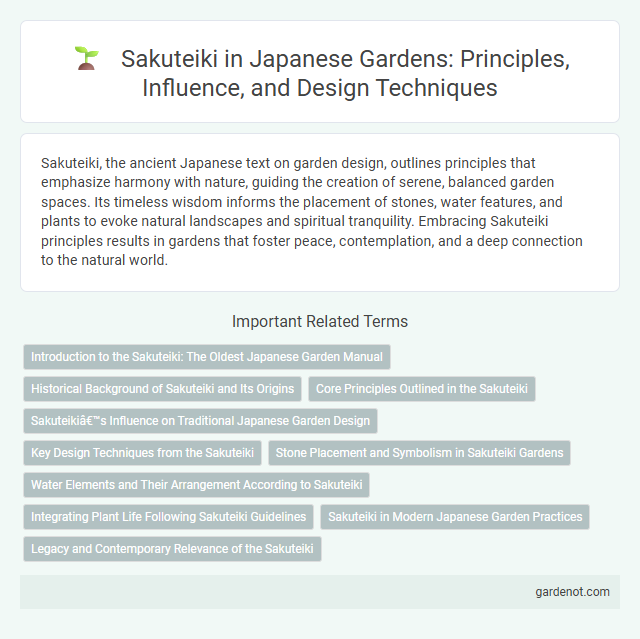Sakuteiki, the ancient Japanese text on garden design, outlines principles that emphasize harmony with nature, guiding the creation of serene, balanced garden spaces. Its timeless wisdom informs the placement of stones, water features, and plants to evoke natural landscapes and spiritual tranquility. Embracing Sakuteiki principles results in gardens that foster peace, contemplation, and a deep connection to the natural world.
Introduction to the Sakuteiki: The Oldest Japanese Garden Manual
Sakuteiki, written in the 11th century, stands as the oldest known Japanese garden manual, offering foundational principles for traditional garden design. It details techniques for arranging stones, water, and plants to create harmonious landscapes reflecting natural beauty and spiritual balance. The text also emphasizes the importance of seasonal changes and the flow of "ki" (energy) within garden spaces to promote tranquility and aesthetic coherence.
Historical Background of Sakuteiki and Its Origins
Sakuteiki, written in the 11th century, stands as the oldest known Japanese gardening manual, providing foundational principles for traditional garden design. Its origins trace back to the Heian period, reflecting aesthetic and spiritual values rooted in Shinto and Buddhist philosophies. The text emphasizes harmony between natural elements and human creativity, influencing the evolution of Japanese gardens for centuries.
Core Principles Outlined in the Sakuteiki
The Sakuteiki, the oldest Japanese garden manual, outlines core principles emphasizing harmony with nature, the flow of water, and the balance of elements to create serene landscapes. Key concepts include the careful placement of stones to evoke natural mountain formations and the importance of asymmetry to reflect organic beauty. These guidelines continue to influence traditional garden design by promoting tranquility and spiritual connection through natural aesthetics.
Sakuteiki’s Influence on Traditional Japanese Garden Design
Sakuteiki, the oldest known Japanese gardening manual dating back to the 11th century, profoundly influences traditional Japanese garden design by establishing foundational principles focused on harmony with nature and the spiritual significance of garden elements. It prescribes specific arrangements of rocks, water features, and plants to create balanced, contemplative spaces that reflect natural landscapes. This text remains a cornerstone for designers seeking authenticity in creating serene, meditative gardens that embody the essence of Japanese aesthetics.
Key Design Techniques from the Sakuteiki
Sakuteiki, the oldest Japanese garden manual dating back to the 11th century, outlines essential design techniques such as "Yukimi" (snow viewing) and "Karesansui" (dry landscape) to evoke natural landscapes through stone placement and water flow simulation. It emphasizes harmony between rocks, water, and plants, creating spiritual balance and seasonal beauty within the garden. The text advises on precise stone arrangements that symbolize mountains and islands, shaping the garden's overall aesthetic and symbolism.
Stone Placement and Symbolism in Sakuteiki Gardens
Stone placement in Sakuteiki gardens follows precise guidelines symbolizing natural landscapes and spiritual elements, reflecting Japanese aesthetics and Zen philosophy. Stones represent mountains, islands, or animals, carefully arranged to create harmony between human design and nature. This symbolic use of stones enhances the garden's role as a meditative space and a reflection of Shinto and Buddhist beliefs.
Water Elements and Their Arrangement According to Sakuteiki
Sakuteiki, the ancient Japanese gardening manual, emphasizes the importance of water elements such as streams, ponds, and waterfalls, reflecting natural landscapes to create harmony. The arrangement of water must follow specific principles like mimicking mountain streams with irregular curves and positioning stones to guide water flow naturally. Proper placement enhances the garden's spiritual balance, promoting tranquility and connection to nature.
Integrating Plant Life Following Sakuteiki Guidelines
Sakuteiki, the oldest Japanese garden manual dating back to the 11th century, emphasizes the harmonious integration of plant life to reflect natural landscapes. It advocates selecting plants that symbolize seasons and enhance the garden's spiritual essence, ensuring a balance between evergreen and deciduous species. Following Sakuteiki guidelines promotes a living environment where flora embodies cultural symbolism and enhances meditative experiences.
Sakuteiki in Modern Japanese Garden Practices
Sakuteiki, the oldest Japanese garden manual dating back to the 11th century, remains a foundational text influencing modern Japanese garden practices by emphasizing harmony between natural elements and spiritual symbolism. Contemporary garden designers draw from Sakuteiki's principles of water flow, stone placement, and seasonal balance to create tranquil, aesthetically balanced spaces that evoke traditional Japanese aesthetics. This integration sustains cultural heritage while adapting to urban environments and modern landscaping techniques.
Legacy and Contemporary Relevance of the Sakuteiki
The Sakuteiki, compiled in the 11th century, remains the oldest known Japanese gardening manual and a foundational text outlining the principles of garden design, emphasizing harmony with nature and spiritual symbolism. Its legacy endures through contemporary Japanese gardens, where designers continue to apply its guidance on water flow, stone placement, and natural scenery to create tranquil, meditative spaces. Modern landscape architects draw inspiration from the Sakuteiki to blend traditional aesthetics with sustainable practices, reinforcing its relevance in both cultural preservation and environmental design.
Sakuteiki Infographic

 gardenot.com
gardenot.com